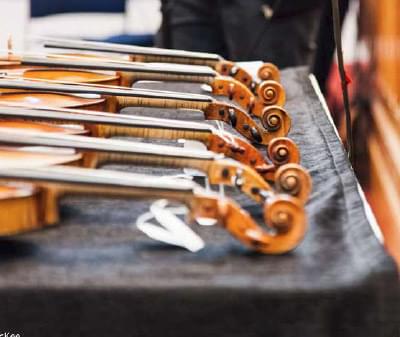Notable Sales: Pietro Giovanni Guarneri of Mantua
The eldest son of Andrea, Pietro Guarneri started to work for his father around 1670. In the early 1680s he left Cremona and settled in Mantua, and is commonly known as ‘Peter of Mantua’ to distinguish him from his nephew, ‘Peter of Venice’. Interestingly, the move to Mantua was probably influenced more by his career as a talented viol and violin player than by his skills as a violin maker. His playing responsibilities at the Court in Mantua occupied much of his time and this explains why only a relatively small number of his instruments survive. The majority of his output consists of violins, with no known violas and only one cello.
Pietro inherited the basics of the Amati tradition from his father, but he was more meticulous than Andrea, and his instruments display an elegance that is rare in the Guarneri family. The decorated violin dated 1685 shows a level of craftsmanship to rival the Amatis – the perfect symmetry of the scroll and f-holes justify Pietro’s position as the finest craftsman of the family. His later work displays a more masculine approach, as can be seen in the striking wood and fuller arch of the circa 1715 violin.
Unfortunately, none of his children followed in their father’s footsteps, although Pietro’s influence can be seen in the instruments of the later Mantuan makers Balestrieri and Camilli.
(b Cremona, 1655; d Mantua, 1720)
The eldest son of Andrea, Pietro Guarneri started to work for his father around 1670. In the early 1680s he left Cremona and settled in Mantua, and is commonly known as ‘Peter of Mantua’ to distinguish him from his nephew, ‘Peter of Venice’. Interestingly, the move to Mantua was probably influenced more by his career as a talented viol and violin player than by his skills as a violin maker. His playing responsibilities at the Court in Mantua occupied much of his time and this explains why only a relatively small number of his instruments survive. The majority of his... Read more
19 April 2021 - Dilworth, John
The Evolution of Violin Making from 16th-20th Century Part IV
02 March 2020 - Dilworth, John
Mantua in the 18th century was a far cry from the glories of its Gonzaga heyday. The seat of the great patron of renaissance music and art Isabella d’Este, the home of Virgil, of the Cremonese-born Monteverdi and the site... Read more
We offer buyers and sellers a bespoke private sale service, sourcing exceptional instruments and bows and matching them with the most discerning buyers.
More InformationTim Ingles and Paul Hayday will offer an initial evaluation of the authenticity and value of your instrument or bow to recommend an auction estimate and reserve price.
Enquire
Tim Ingles and Paul Hayday will offer an initial evaluation of the authenticity and value of your instrument or bow. At this stage, the assessment is free and without obligation. In the first instance, we suggest submitting good-quality images to us, preferably by email to info@ingleshayday.com or by completing the valuation form.
Read more